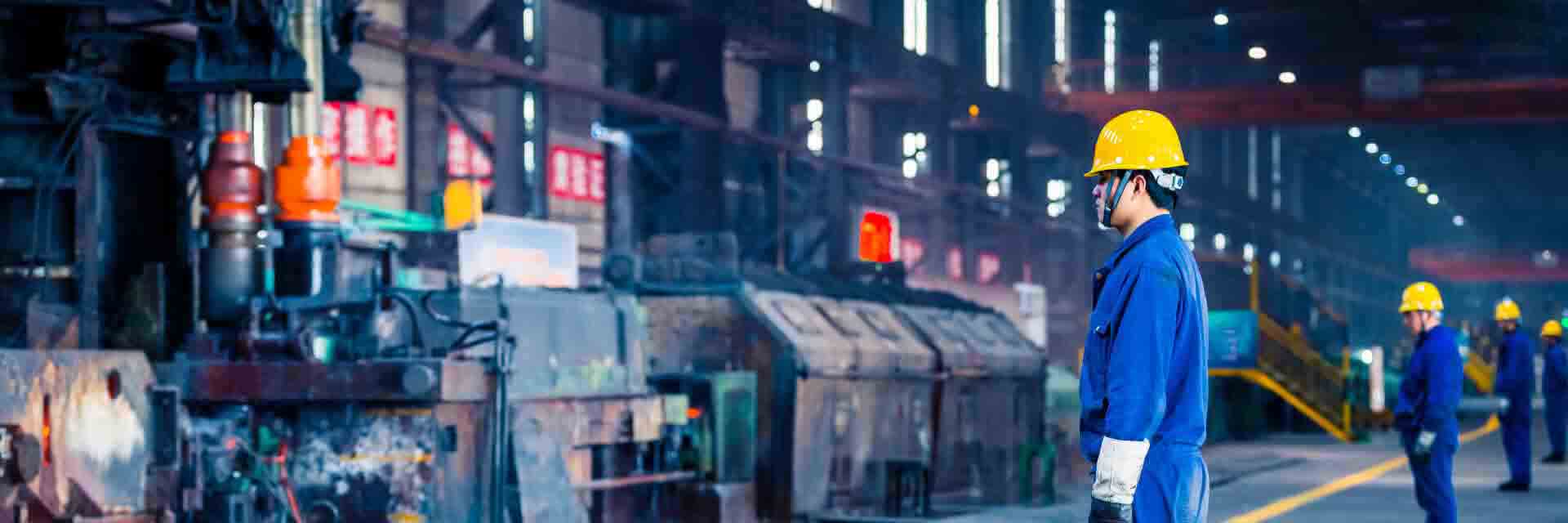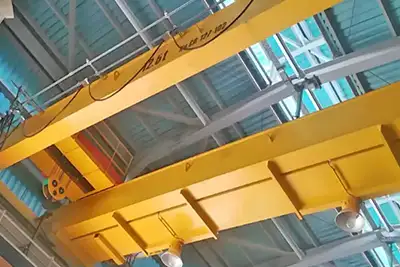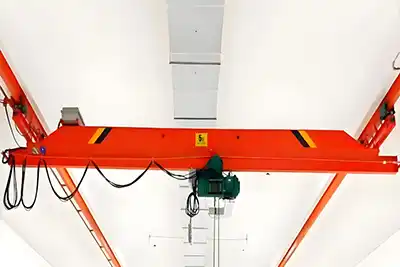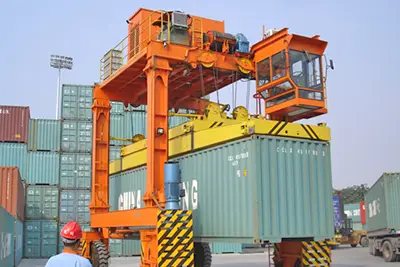Top Quality Checks for 20 Ton Overhead Crane Buyers
Inspect welding, beam accuracy & safety testing to identify top 20 ton overhead crane manufacturers & avoid failures. 20 ton overhead crane for sale.
Introduction
Why It Matters: Choosing a Trustworthy Manufacturer for Your 20 Ton Overhead Crane
Buying a 20-ton overhead crane isn’t something you do casually. It’s a major investment—one that affects not just your initial budget, but also your workshop’s long-term productivity, safety, and operating costs. That’s why the reliability of the manufacturer you choose is just as important as the crane’s technical specs.
Let’s put it this way: a crane that breaks down in six months due to poor welding or misaligned beams doesn’t just hurt your wallet. It stalls operations, delays shipments, risks worker safety, and gives you a headache that no buyer wants to deal with.
Why Quality Checks Should Be on Every Buyer’s Radar
Crane manufacturers aren’t all built the same. Some follow tight quality control processes backed by inspection reports and third-party audits. Others? Not so much. That’s why looking into a manufacturer’s quality checks before you sign the purchase order is crucial.
Here’s what strong quality control processes give you:
- Better structural safety – no cracks in welds, no loose joints.
- Longer crane lifespan – beams and wheels stay aligned, motors run smoothly.
- Lower maintenance bills – fewer unexpected repairs or component failures.
- Easier installation – when the span and camber match the drawings, installation is faster and cleaner.
What This Guide Is For
This guide is for serious buyers—especially those looking into 20-ton overhead cranes—who want to know what really separates a good manufacturer from a careless one. We’ll break down:
- The most critical quality checks you should expect to see.
- What they mean for the long-term performance of your crane.
- How to recognize a reliable supplier by the inspection data they provide.
If you're buying a crane to last 10+ years, this is the stuff you’ll want to know—before you place the order.
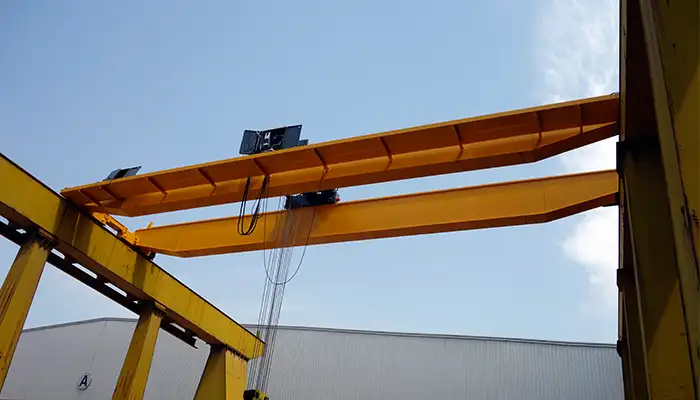
20 ton overhead crane for sale, double girder overhead crane design
Welding Quality: The Backbone of Structural Integrity
Why You Should Care About the Welds—Seriously
When it comes to a 20-ton overhead crane, the welding is what holds everything together—literally. Poor welds are one of the most common reasons cranes fail, especially under full load. And once a weld cracks or breaks under stress, it’s not just expensive to fix—it’s dangerous.
A solid crane frame with properly welded joints ensures the crane stays stable during lifting, resists deformation, and performs reliably for years. Skipping over weld quality is like building a house on sand. It may stand for a while, but not for long.
What Can Go Wrong with Bad Welding?
Even if you’re not a welding expert, there are a few red flags you can ask about or spot in an inspection report. These are common defects that can weaken the crane frame:
- Porosity: Tiny holes in the weld caused by trapped gas. These reduce weld strength.
- Cracks: The most serious defect. Cracks can grow over time and lead to sudden failure.
- Slag Inclusion: Leftover welding debris trapped in the joint. It prevents full metal bonding.
- Undercuts: Small grooves at the base of the weld that act like stress risers and weaken the joint.
- Inconsistent bead or skipped welds: Aesthetics aside, uneven welds may suggest rushed work or poor technique.
If any of these show up in an inspection report or factory photo, take a pause and ask more questions. They could cost you in downtime and repairs later.
How Welds Are Inspected—And What You Should Ask For
Reliable crane manufacturers don’t just “eyeball” their welds. They use proper inspection methods during and after fabrication. These are some methods that you, as a buyer, should expect to see mentioned in the factory inspection report:
- Visual Inspection: The most basic check—done by trained inspectors to look for surface-level defects.
- X-Ray Testing: Used to check the internal structure of critical welds (especially in tension-bearing areas). Required for higher safety-grade applications.
- Ultrasonic Testing (UT): Detects internal flaws like inclusions or cracks without damaging the weld.
- Magnetic Particle or Dye Penetrant Testing: Sometimes used for surface crack detection, especially in high-load areas.
If your manufacturer says “all welds checked,” ask them: “How?” You should receive documentation showing which method was used and whether it passed relevant standards.
Don’t Forget the Standards—They Matter More Than You Think
In many countries, certified welding standards aren’t just suggestions—they’re required by law or industry best practices. Two you’ll often see are:
- GB3323 (China’s national X-ray inspection standard): If you’re buying a crane from China, this is the benchmark for welded seam X-ray inspection.
- AWS D1.1 (American Welding Society): Common in North America and internationally respected for structural steel welding.
Always ask if the manufacturer complies with these or similar standards. A reliable supplier will include this in their inspection report or offer a certificate.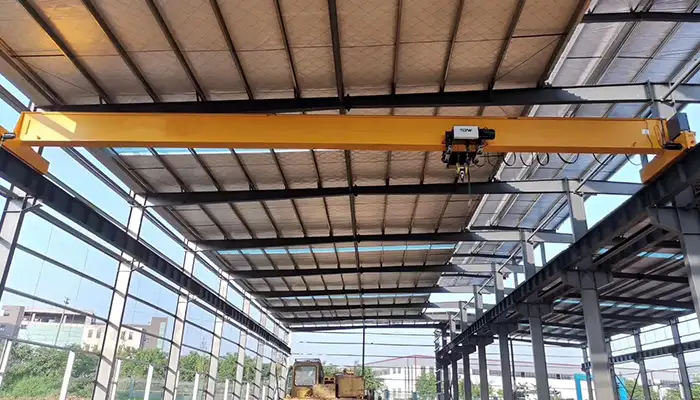
Single girder overhead crane design for your reference
Beam Dimensions and Structural Accuracy
Why Precise Beam Dimensions Are Not Just a Technical Detail
When you're lifting 20 tons of steel, precision matters. A crane’s main beam isn’t just a piece of metal—it’s the spine of the entire structure. If it’s off by even a few millimeters in the wrong place, that error can ripple through the entire system: poor trolley movement, uneven load distribution, track misalignment, and faster wear on mechanical parts.
Let’s be honest—many buyers overlook this part. It’s easy to get caught up in lifting capacity and price. But the structural accuracy of the beam is what ensures that your crane performs smoothly day after day.
What to Check: Critical Beam Dimensions That Affect Crane Performance
There are a few key areas where accuracy really matters. These aren’t just numbers on a drawing—they directly affect how safely and efficiently your crane operates.
Main Beam Span and Dimensional Deviation: This is the actual length from end to end. If the span is off even slightly, the end trucks and wheels may not align with the runway, causing noise, friction, or even derailment.
- What to expect: Span deviation should be within ±2mm for cranes with spans over 10 meters.
Beam Camber (Upward Curvature): Camber helps counteract deflection when the crane is loaded. If camber is too low, the beam may sag under load; if too high, it causes instability.
- Typical range: For a 20-ton crane, camber is usually between 1.3–1.6 times the span (S) per 1000 mm, and it must stay within S/10 at most.
I-Steel Joint Reinforcement and Surface Finish : The joints where I-beams are connected must be reinforced and flush. Poorly joined or rough surfaces can damage the trolley wheel, increase vibration, or catch debris.
- Buyer tip: Ask if the I-beam joint areas are reinforced with plates and whether the surface is polished for smooth trolley travel.
How Dimensional Accuracy Affects Real-World Crane Use
You might think a few millimeters don’t make a big difference. But when a 20-ton crane runs on tracks with that small misalignment, things wear out fast.
- Wheels and rails grind unevenly, causing early failure.
- Trolley movement becomes jerky or slow.
- Load may shift slightly during travel—bad for safety.
- Installation becomes complicated, costing more time and money.
In some cases, a crane with bad beam geometry can’t even be installed without rework. That means factory adjustments or field welding—both of which cost you.
What Tolerances Should Buyers Expect?
If you're reviewing an inspection report (or asking for one), here are reasonable numbers to look for:
Span deviation:
- Up to 10m span: ±2mm
- Over 10m: ±[2 + 0.1(S−10)] mm
Beam camber:
- About 1.3–1.6 mm per meter of span (S)
- Max camber value should not exceed S/10
Bridge diagonal deviation (E1−E2):
- Within 5 mm
Wheel center deviation (for beam alignment):
- Within 1–3 mm depending on wheelbase and span
These tolerances are not just “nice to have”—they’re what keep your crane from becoming a maintenance nightmare.
Safety Tests and Compliance Checks
Because When You're Lifting 20 Tons, Safety Isn't Optional
It doesn’t matter how sleek the design is or how low the price looks—if the crane isn’t safe, it’s not worth buying. A 20-ton overhead crane deals with massive loads, often operating above people, machinery, and valuable materials. One failure could cause serious injury, major production losses, or worse.
That’s why every serious crane manufacturer runs a series of safety tests before delivery. These tests aren't just technical exercises—they’re real-world indicators of whether your crane will perform reliably without putting anyone at risk.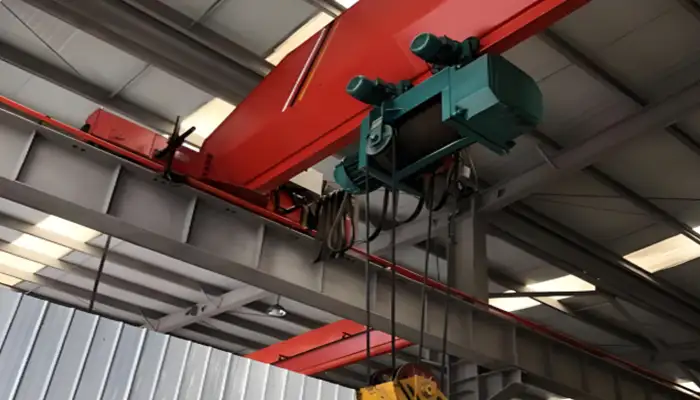
economcial single girder overhead crane 20 ton design
Key Safety Tests Every 20 Ton Overhead Crane Should Pass
If you’re reviewing a factory inspection report—or about to ask for one—make sure these specific tests are covered. They’re your baseline for safe operation.
Load Testing (Rated Capacity and Overload Test): This test ensures the crane can lift and hold its full rated capacity—20 tons in this case—without deformation or failure. In many cases, it’s tested at 125% of rated load to verify strength under overload conditions.
Look for: Certified test results showing the crane successfully lifted 25 tons (if tested at 125%).
Wheel Alignment & Vertical/Horizontal Deviation Check: Misaligned wheels don’t just wear out fast—they cause vibration, tracking problems, and can even derail the crane.
Expect:
- Horizontal deviation (tgΦ): −0.0015 to +0.0015
- Vertical deviation (Tga): within 2 mm
Noise Level Testing : This is often overlooked, but it's important for operator comfort and nearby workers. A loud gearbox or motor might be a sign of poor-quality components.
- Industry standard: Noise should be ≤85 dB(A) at 1 meter from the equipment.
Certifications That Prove Safety and Compliance
Good manufacturers don’t just say “our crane is safe.” They back it up with proper documentation. Here's what you should ask for:
- CE Certification (for EU markets): Confirms compliance with European health, safety, and environmental protection standards.
- ISO 9001 / ISO 14001: Shows the factory follows internationally recognized quality and environmental management systems.
- OSHA Compliance: For cranes delivered to the U.S., check if the product aligns with OSHA lifting equipment safety requirements.
- GB Standards (for Chinese cranes): For example, GB3811 for crane design, GB3323 for weld X-ray inspections.
You should be able to request copies of these certifications as part of your pre-delivery inspection file. If the supplier hesitates or says it’s “not available,” that’s a red flag.
How Do Manufacturers Prove It?
Reputable manufacturers go beyond just in-house testing. They often bring in third-party inspectors (from SGS, TUV, or local authorities) to verify quality and safety.
Here’s what to expect in a strong inspection record:
- Third-party inspection stamp or signature
- Clear test data (load, deviation, weld pass/fail)
- List of testing equipment used and calibration dates
- Photo records of testing in progress (optional, but useful)
Buyers should always ask for this final inspection report before shipment. It’s one of the easiest ways to protect your investment.
Additional Quality Indicators Buyers Should Consider
It’s Not Just About Lifting—It’s About Long-Term Reliability
For a 20-ton overhead crane, the lifting power is only half the story. The other half is about how well it holds up after months—or years—of heavy use. That’s where attention to “small” quality details makes a big difference. These aren’t just technical specs; they’re clues to the overall build quality and the kind of service life you can expect.
If you’re serious about making a smart crane investment, don’t skip these indicators.
Surface Finish & Weld Seam Smoothness
Protecting your crane from corrosion and long-term fatigue
A well-finished surface doesn’t just look better—it performs better. Smooth, clean welds and properly treated surfaces reduce the chance of rust, paint peeling, and metal fatigue.
- Rough or uneven welds can trap moisture and allow corrosion to start.
- Uncleaned weld spatter may cause trouble when the trolley passes over them or during future maintenance.
- No sharp burrs or welding scars – these can be dangerous and weaken nearby steel over time.
What to check in the inspection report or photos:
- Are weld seams flush with no porosity or irregular shapes?
- Are surface treatments like primer, paint, or galvanizing properly applied?
- Is there mention of burr removal or surface polishing?
Material Quality and Sourcing Transparency
Knowing where your steel and components come from matters
You can’t see it from the outside, but the quality of raw materials used in the crane frame, wheels, and hoisting mechanism makes or breaks durability.
- Steel grades used for beams and support frames should meet mechanical performance standards.
- Gears, motors, and bearings must come from reputable sources—not unknown brands with no traceability.
- Electrical components should meet voltage and insulation requirements for your region (220–480V, 50/60Hz, etc.).
Questions to ask your supplier:
- “Can you show me the steel material certificate?”
- “Where are the hoist and motor components sourced from?”
- “Do you use any standardized parts from known brands like Schneider, Siemens, SEW, or ABB?”
A quality-conscious supplier will answer these without hesitation.
Factory Inspection Reports & Traceability
Documentation is your insurance policy
A thorough inspection report isn’t just a formality—it’s proof that your crane was built and tested to spec. Make sure the report includes:
- Each tested component and dimension (welds, span, camber, wheel deviation, noise level, etc.)
- Clear results (Pass/Fail, numerical measurements, tolerances)
- Inspector's name or stamp
- Date of inspection and crane serial number for traceability
Pro tip: Ask for a digital copy of the factory inspection report before shipment. It’s much harder to resolve issues once the crane has been installed.
Manufacturer Experience, After-Sales Service & Warranty
What happens after the sale is just as important as before it
Don’t just look at the product—look at the company behind it.
- Years of manufacturing experience count. A company that’s been building cranes for 15–20 years likely has systems in place for quality control and customer support.
- Warranty terms should be clear—at least 1 year for mechanical and electrical parts is standard.
- After-sales support matters for troubleshooting, spare parts supply, and service guidance.
Questions to ask:
-
“Do you have installation guidance or on-site support?”
-
“What’s included in your warranty?”
-
“Do you have a spare parts list or supply chain after delivery?”
Buyers who skip these questions often regret it later—especially when small service needs become big headaches.
How Buyers Can Verify Manufacturer Quality
Don’t Just Trust—Verify Before You Buy
Choosing a 20-ton overhead crane is a major investment. While many suppliers promise high quality, not all of them back it up with solid proof. That’s where you, as the buyer, can take a few smart steps to make sure you’re dealing with a reliable manufacturer before signing any contract or making a deposit.
1. Ask for Detailed Factory Inspection Reports and Test Certificates
These are more than documents—they're your first defense against costly issues.
A trustworthy supplier will have no problem sharing inspection documents that cover:
- Welding inspection results (including visual checks or X-ray tests if applicable)
- Dimensional data: span, camber, wheel alignment, beam deflection, etc.
- Load test results and noise level readings
- Third-party verification, if performed
- Material certificates (steel, electrical components, hoist gearboxes)
Tip: Look for clear pass/fail markings, inspector signatures, and actual values—not just generic "OK" checkmarks.
2. Visit the Factory or Request a Virtual Tour
Seeing is believing—especially when heavy equipment is involved.
If you’re buying multiple cranes or spending a large budget, an in-person visit is ideal. But if that’s not possible, ask for a live video tour or pre-recorded walkthrough of:
- Welding stations and beam fabrication areas
- Quality control zones and testing rigs
- Load testing demonstrations
- Final assembly and packaging
What to observe: Is the workshop organized? Are workers wearing PPE? Are cranes being tested one by one or just stacked for shipment?
A factory that hides its production process usually has something to hide. A transparent one will show you every step.
3. Compare Inspection Reports from Multiple Suppliers
The differences can be eye-opening.
If you’ve shortlisted 2–3 crane manufacturers, ask each of them for a sample inspection report from a previous 20-ton crane delivery.
Then compare:
- Level of detail and formatting
- Inclusion of actual data points (not just general checks)
- Type of testing performed
- Proof of standards compliance (GB, CE, ISO, etc.)
Bonus insight: The more transparent and data-driven the report, the more likely you’re dealing with a serious and reliable supplier.
4. Ask for Customer References and Product Feedback
Past buyers are your best source of honest reviews.
Don’t hesitate to request a list of customers who’ve bought a similar crane (ideally a 20-ton single girder model). You can ask:
- “Were you satisfied with the crane’s long-term performance?”
- “Was installation smooth?”
- “Did the company support you when problems came up?”
- “Would you buy from them again?”
Tip: Ask for clients in your region or industry. If the supplier has sold to customers in steel fabrication, machinery workshops, or foundries like yours—that’s a strong sign.
Conclusion
The Right Crane Isn’t Just Built—It’s Verified
A 20-ton overhead crane is more than just heavy steel and motors—it’s the backbone of your material handling system. And when safety, uptime, and efficiency are on the line, cutting corners in quality just isn’t an option.
That’s why the best crane manufacturers don’t just build cranes—they prove their quality before you ever take delivery.
Key Quality Checks That Separate Reliable Suppliers from the Rest
Let’s recap the most important things buyers should look for when reviewing factory inspection reports:
- Welding Quality: Clean weld seams, no cracks, porosity, or slag. Welds in tension zones should meet X-ray inspection standards like GB3323 Grade II.
- Beam Accuracy: Correct span dimensions, camber, and deflection values—typically within ±2 mm for span, with beam camber kept between 1.3~1.6‰ of the span.
- Safety Testing: Verified results from load testing, wheel alignment checks, and noise level testing all demonstrate real-world performance and durability.
- Material and Component Verification: Certification of steel grade, hoist sourcing, and motor/electrical brand origin.
- Surface and Finish Quality: No burrs, slag, or rough welds that could cause premature wear or corrosion over time.
These aren’t just numbers—they reflect how well the crane will perform every day, resist wear, and keep operators safe.
Quality Isn’t Expensive—It’s a Long-Term Savings Plan
Yes, it’s tempting to compare cranes by price alone. But the cheapest quote may cost you much more down the line—in repairs, downtime, and even safety incidents.
Instead, we encourage every buyer to:
- Request full inspection reports with measurable values and real test data
- Ask detailed questions about welding standards, beam tolerances, and load test practices
- Verify manufacturer credibility through certifications, client references, and service support
When a manufacturer provides transparent, traceable quality checks, you’re not just buying a crane—you’re buying peace of mind.
If you're currently evaluating offers for a 20-ton overhead crane, don't hesitate to ask for a sample inspection report. It can tell you far more than a glossy brochure ever will.
Single Girder 20 Ton Overhead Crane Factory Inspection Report for Your Reference
Factory Inspection Report
Model |
HD20t-17.4m |
Max.Traveling Speed |
20m/min |
||||
|
U-shape steel |
450×500×1005 |
Wheel Groove |
90mm |
||||
|
No. |
Item |
Unit |
Quality index |
Self inspect |
Special inspect |
result |
remark |
|
1 |
Inside quality |
-- |
1.Weld without obvious defects, such as leakage welding, porosity, slag inclusion, crack; |
√ |
accord |
qualified |
|
|
2 |
Dimensional deviation from wheel tread to top of main beam |
mm |
Accord with drawing |
√ |
|
||
|
3 |
Deviation between center of I-beam center and main beam certer |
mm |
≤3 |
√ |
|
||
|
4 |
Span deviation |
mm |
S≤10m, △S=±2 |
Driving wheel-1 |
Driving wheel-1 |
|
deviation≤2mm |
|
5 |
Bridge diagonal deviation |
mm |
{E1-E2}≤5 |
1 |
1 |
|
|
|
6 |
Wheel deviation |
mm |
W≤3m, △W=±3 |
√ |
|
|
|
|
7 |
Main beam camber |
mm |
△F=(1.3~1.6)S/1000, and △Fmax is within mid-span S/10 |
1.6 |
29 |
|
|
|
8 |
Wheel vertically deviation |
mm |
Tga=0.0005~0.0030 |
√ |
Accord |
Qualified |
a≤2mm |
|
9 |
Wheel horizontally deviation |
mm |
tgΦ=-0.0015~+0.0015 |
√ |
|
||
|
10 |
Main beam side bending value |
mm |
△fp≤S/2000 |
2 |
|
||
|
11 |
Partial deflection of girder web |
mm |
|
√ |
|
||
|
12 |
Wheel strength point height difference |
mm |
S≤10m, △h=±2; 10<S≤15m, |
1 |
Qualified |
|
|
|
13 |
I steel joint |
-- |
There should be strengthened plate at I - steel joint, track surface should be polished |
√ |
|
|
According to I steel joint technology requirements. |
|
14 |
Welding and surface |
-- |
No obvious defects, such as porosity, slag inclusion, undercut, crack, etc., no welding scar, slag cutting, burr, uneven convex and concave in appearance, the size shall meet the requirements of the drawing; |
√ |
|
|
|
|
15 |
Crane driving noise |
dB |
Measure from the ground(measure distance is1m), the noise of motor and reducer should be≤85dB(A) |
√ |
|
|
|
|
|
|
|
|
|
|
|
|

